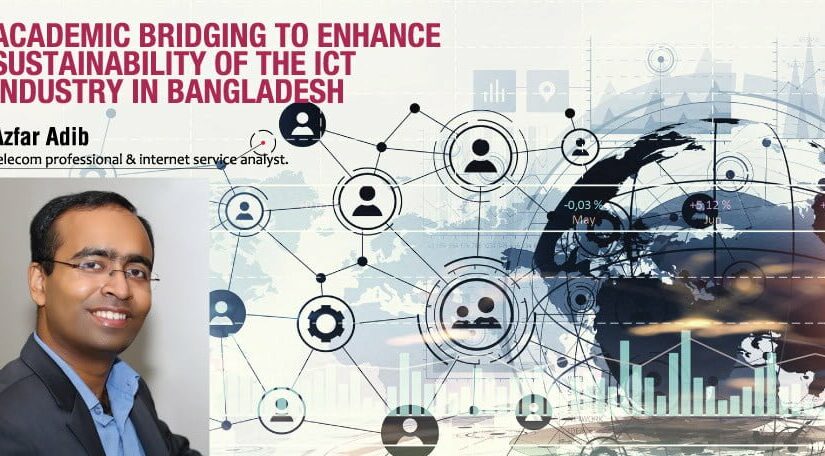
ACADEMIC BRIDGING TO SUSTAIN THE ICT INDUSTRY IN BANGLADESH
With an USD 800 million in export earnings in 2017 (which was just USD 26 million in 2009) and over 1500 organization having direct-indirect engagement of 0.25 million people; ICT (information and communication technology) sector in Bangladesh has been experience exponential growth, unique exposure-emphasis and crucial impact in almost every arena of the country during last few years. This industry can be divided into two broad categories-IT and ITES. IT category basically includes application services, communication services and engineering services, while ITES consist of all sort of outsourcing and automation services.
Bangladesh ICT industry have been flourishing based on multiple advantages, like: large domestic and global market, favorable government policies in certain aspects, large pool of young-capable workforce and lower cost of operations. The industry obviously has been facing and trying to overcome multiple challenges in various dimensions like infrastructural, financial, regulatory, technical etc. Very recent up-gradation of Bangladesh from ‘Least Developed Country’ (LDC) to ‘Developing Country’ may generate a stimulating scenario in this regard.
On 20 March 2018, United Nations officially announced the eligibility of Bangladesh (through fulfilling certain requirements regarding Gross National Income, Human Assets Index, Economic Vulnerability) for up-gradation into ‘Developing Country’ category. It is undoubtedly a highly prestigious achievement which facilitates elevated status for the country in international arena along with greater access to foreign investment. However, it involves several challenges as well like: increased interest on international loans, reduction in grace period & loan repayment window, termination of various duty facilities, etc.
Continuous and steady GDP growth of Bangladesh (often termed as one of fastest growing economies of the world) has been largely driven by its exports of readymade garments (RMG), foreign remittances and the domestic agricultural sector. Termination or reduction of various duty facilities in buyer countries may create significant impact on the RMG sector. Lower production cost originated through cheap labor has been a key strength of this sector, which may also get threatened due to rapid automation in other competing countries (which will facilitate them faster product at lower cost). In such circumstances, RMG and other relevant industries of Bangladesh need to up-grade and adopt through innovative approach, which can obviously be facilitated through the ICT sector of the country.
Here comes the key question, how much innovation and R&D are actually being accommodated in the ICT industry of Bangladesh. In a tech-follower (rather than tech-inceptor) country like Bangladesh, the answer is mostly negative. Several other factors are also attributed in this regard. A significant portion of ICT industry here is just performing operation-maintenance of imported solution-equipment, while a big portion is complete engaged in outsourcing activities. For both these segments, the need for R&D is limited in general. The rest segment (application/service development) can be considered comparatively progressive, but those are also mostly based on derived solution through ready-made platforms rather than end-to-end innovation.
Another big factor here is the outlook; which means mindset, awareness and approach of the people who are involved or being served by this industry. While majority portion actually do not feel the need of pure R&D for product-solution development (as just use or sell of imported elements can serve their purpose well), there remains very low level of awareness regarding available schemes of R&D particularly through industry-academia collaboration.
Author :
AZFAR ADIB
Grameenphone Ltd | Telenor Group